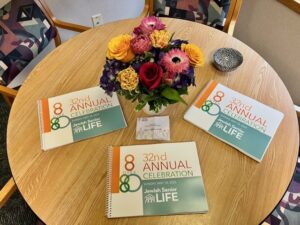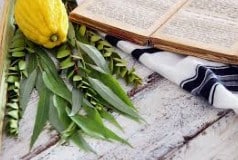SUKKOT 5783
By Jo Strausz Rosen
Modern readers will find very few pages on Sukkot in The Newish Jewish Encyclopedia. Although it ranks low on the irreverent tome’s “religi-o-meter,” the weeklong holiday ranks high on our joy meter.
When Is Sukkot?
This year our fall harvest festival begins at sundown on Sunday, October 9, the 15th Day of the month of Tishrei, and ends at sundown on Sunday, October 16. The celebration marks the pilgrimage Jews made to the Temple in Jerusalem, carrying with them fruits and sacrificial animals. The festival of Sukkot is about the joy of knowing that all our sins are forgiven, and some say this is the miracle. The tradition continues as those who observe the holiday build temporary dwellings immediately following Yom Kippur. The celebration is enhanced by decorating the 4 walls with art and preparing delicious foods to be eaten with family and friends in the sukkah.
Sukkot Jewish Holiday
“Sukkot is without a doubt the most action-packed of all Jewish holidays. We’re commanded to build a temporary dwelling, take our meals al fresco, shake special tree branches and so on,” wrote the authors of The Newish Jewish Encyclopedia.
“The first two days of Sukkot are considered the holiday proper, the following five are referred to as Hol Hamoed, or the weekdays of the festival. During these days, none of the holiday’s religious restrictions apply, but Jews are forbidden from strenuous work and are commanded to use that time for enjoyment.”
“The best-known Sukkot custom involves the Four Species, Arba Minim. A palm frond (lulav), myrtle tree boughs (hadass), willow tree branches (aravah), and a citron (etrog). Throughout the holiday, the four are held together and waved around daily with an accompanying prayer, a commemoration of a similar ceremony practiced by the Temple’s priests in the ancient days. The Four Species symbolize both nature’s offerings and humanity’s diversity: the lulav has taste but no smell, symbolizing those Jews who read the Torah but don’t bother with good deeds; the hadass is fragrant but tasteless, symbolizing those Jews who do good deeds but don’t read the Torah; the aravah has neither taste nor smell, just like those Jews who care for neither good deeds nor the good book; and the etrog has both, symbolizing one perfect Jew.”
Sukkot at Jewish Senior Life
At JSL our residents are treated to religious services with Rabbi Polter and share the holidays in the campus Sukkahs. As part of the Meer Patio and Gardens campaign, we are planning to build a year-round pergola that will serve as a Sukkah during this sacred season.
May the bounties of the celebration of Sukkot bind you and your family in togetherness, love, and prosperity. “Blessed are You, Lord our Gd, King of the Universe, who has sanctified us with His commandments and has commanded us to kindle the light of the Festival Day.”









